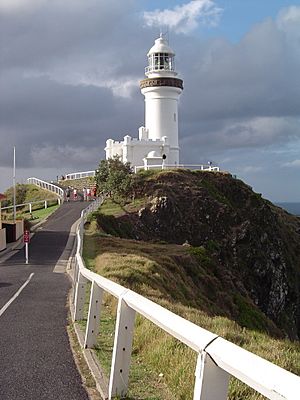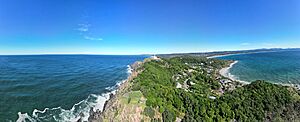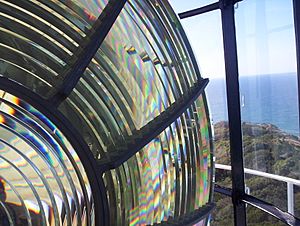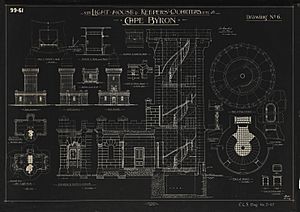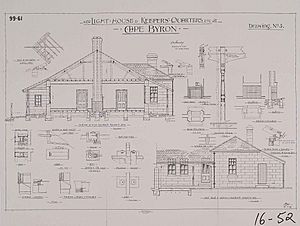Cape Byron Light facts for kids
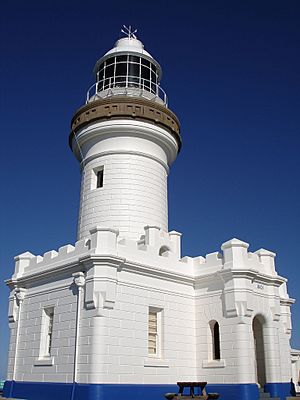 |
|
| Cape Byron Light in 2006 | |
| Location | Lighthouse Road, Byron Bay, Cape Byron, Byron Shire, New South Wales, Australia |
|---|---|
| Coordinates | 28°38′19″S 153°38′11″E / 28.63861°S 153.63639°E |
| Year first constructed | 1901 |
| Construction | Concrete blocks |
| Tower shape | Cylindrical tower with balcony and lantern |
| Markings / pattern | White tower and lantern |
| Height | 23 metres (74 ft) |
| Focal height |
|
| Original lens | 1st order Henry-LePaute Fresnel lens |
| Intensity | 2,200,000 candela |
| Range |
|
Cape Byron Light, also called Cape Byron Lightstation, is an active heritage-listed lighthouse located at Cape Byron in New South Wales, Australia. It was designed by Charles Harding and Cecil W. Darley and built between 1899 and 1901. This famous landmark is also known as the Byron Bay Lighthouse.
Today, the Cape Byron Lightstation is more than just a lighthouse. It's also a maritime museum, a place for visitors to learn, and a popular tourist spot. The property is owned by the NSW National Parks & Wildlife Service.
The lighthouse was added to the Commonwealth Heritage List in 2004 and the New South Wales State Heritage Register in 2019. It is Australia's most powerful lighthouse, shining with an amazing 2,200,000 candelas of light! Cape Byron is the easternmost point of mainland Australia, about three kilometres (2 mi) northeast of Byron Bay town.
Contents
A Look Back at Cape Byron's Past
Ancient History: The Bundjalung People
For thousands of years, the Cape Byron headland has been a very important place for the Bundjalung people of Byron Bay. They traditionally called this area Cavanba. The cape and its surroundings gave the local Aboriginal people everything they needed for life and culture.
The Bundjalung people lived across a large area, from the coast up the Richmond River and inland. The coastal areas, forests, and rainforests were full of resources. They found plenty of marine life, plants, and animals for food. They also used different plants and animal materials to make tools like shields, spears, boomerangs, and canoes.
Besides food and tools, the cape was also a special place for spiritual and cultural practices. For Aboriginal communities, these practices connect people to their land and to ancient stories and spirits. They keep their culture alive through rituals, dance, songs, and paintings.
The top of the Cape Byron headland was a great lookout spot for the Bundjalung people. They used it for finding food, meeting others, and for religious ceremonies. It was traditionally an important men's site for special ceremonies and learning their laws.
European Arrival: Changes to the Land
Captain James Cook first saw Cape Byron on May 15, 1770. He named it after his fellow sailor, Vice-Admiral John Byron. However, Europeans didn't explore northern NSW until 1826. That's when Captain Henry John Rous explored the area looking for rivers and safe places to anchor ships. This was likely the first time the Bundjalung people met European settlers.
European settlement in the Byron Bay area began in the 1840s. Cedar cutters came, attracted by the rich forests and easy access to shipping. At first, they had a peaceful relationship with the traditional owners. But soon, conflict started when farmers arrived. They began clearing land and bringing in livestock.
The Bundjalung people had always used the natural resources in a balanced way. The new settlers disrupted this balance and pushed Aboriginal people off their land. With less land, resources, and sacred sites, and a growing need for European supplies, conflict grew. Many Aboriginal people were lost due to violence and new diseases.
By the time Byron Bay was settled in 1881, many surviving Aboriginal people worked for the Europeans. They were laborers, shepherds, guides, or domestic helpers. In 1883, Byron Bay became a main center for cedar trading. The town was officially named Byron Bay in 1896, which further changed the Bundjalung people's connection to their land.
Building the Lighthouse: A Guiding Light
Lighthouses are built around the world to keep ships safe from dangerous seas. They act as guides, helping sailors navigate tricky coastlines and find their way into harbors. The first lighthouse in Australia was built in 1818 in Sydney. But it wasn't until the mid-1800s that a clear plan for lighthouse design was made across NSW.
As towns grew and trade increased, protecting ships and people along the coast became very important. Two key figures, Francis Hixson and James Barnet, worked together. Hixson was in charge of lighthouses, and Barnet was the Colonial Architect. They created a "highway of lights" along the NSW coast, making sure all lighthouses looked and worked well together.
Hixson wanted to light up the coastline "like a street with lamps." The decision to build the Cape Byron Light was made in the late 1890s. The site was prepared in October 1899.
Barnet designed many lighthouses, making them look similar but also fit their unique locations. Each lighthouse station had a main tower, homes for the Head Keeper and Assistant Keepers, and other buildings for running and maintaining the light.
Cape Byron was a prominent headland with deep water, so a lighthouse wasn't thought necessary at first. But by the 1890s, it was seen as one of the last big lighthouses needed to complete Hixson and Barnet's plan. Charles Assinder Harding, Barnet's successor, designed the Cape Byron Lighthouse. He also designed Norah Head Light and Point Perpendicular Light, keeping a similar style to Barnet's designs.
Harding worked under Cecil W. Darley, the Engineer-in-Chief. He designed a tower and station for Cape Byron that fit the original vision but also used new technology. The headland rises 100 metres (330 ft) above the Tasman Sea. Harding designed a relatively short, circular tower (13.5 m to the lantern base). It had an entrance, workroom, and kerosene store at its base. The station also included homes for the keepers, a signal station, and other buildings.
Harding used a new building method: precast concrete blocks. He had tried this at the Point Perpendicular Light in 1898. This method was cheaper and faster because the blocks could be made on-site. It meant they didn't need to transport heavy stone or skilled stonemasons. The Cape Byron Lightstation's design is almost identical to the one at Point Perpendicular because this method was so successful.
Construction began in July 1900 by contractors Mitchell and King. The total cost was about A£10,042 for the building, A£8,000 for the light equipment, and A£2,600 for the road. The lighthouse was finished in 1901. It was officially opened by the NSW Premier, John See, on December 1, 1901. Newspapers at the time said it was one of the finest and most beautiful lightstations in NSW.
The Cape Byron Lightstation first had a Head Keeper and two Assistant Keepers, who lived there with their families. In 1915, the Australian Government took over the lighthouses. Over time, many lighthouses became automated, meaning they didn't need keepers anymore. Cape Byron Lightstation switched from kerosene to electricity in 1959. Keepers continued to work there until 1989 because their presence was still helpful, and it was close to Byron Bay.
Today, the Cape Byron Lightstation still helps guide ships. Its care is now shared by the Cape Byron Headland Reserve Trust, the National Parks & Wildlife Service, and the local Arakwal people.
It is the most visited lighthouse in Australia. Standing at the easternmost point of Australia, its light can be clearly seen from Byron Bay. This makes it a strong symbol for the local community. The headland is also a popular tourist spot because of its natural beauty and rich history.
The Cape Byron headland also has a bright future. Educational programs teach visitors about the Aboriginal culture of the cape. The Arakwal people call it Walgun, meaning 'The Shoulder'. These programs show how the Aboriginal cultural heritage is not just from the past but is thriving today. This is thanks to the shared care and management of the reserve by the Arakwal people.
What the Cape Byron Lightstation Looks Like
The Cape Byron Lightstation is spread along a narrow ridge at Australia's easternmost point. It includes the lighthouse tower, homes for the Head Keeper and Assistant Keepers, and a workshop/store building. There's also a modern cafe and toilet building near the Head Keeper's Quarters.
A timber fence generally surrounds the area, following the original boundary. Smaller picket fences enclose the buildings and yards of the keepers' homes. The site has lawns and paved areas for parking and walking paths.
The Cape Byron Lighthouse is a round tower, about 22 meters tall to the top of its lantern. It's built from precast concrete blocks on a solid concrete base. Inside, a circular concrete staircase with metal railings leads to the upper rooms. Another metal staircase goes up to the lantern room. The lighthouse has a concrete balcony with a stone railing.
Inside the lighthouse, there's a museum. It displays important historical items. These include a red sector light from 1889, the original curved timber desk from 1899-1901, and the clockwork winch from 1901.
A small flag store building is attached to the lighthouse tower. It still has its original timber pigeonholes.
The Head Keeper's Quarters is a single-story building south of the lighthouse. It's made of rendered concrete blocks with a red tile roof, in a Victorian Georgian style. It has five main rooms, a kitchen, laundry, bathroom, and a separate store and toilet. A verandah wraps around all sides of the house.
This home still has many original features, like wall finishes, picture rails, and doors. The original timber floors are still there. A telephone, which connected the lighthouse and the house, is also intact. The kitchen, laundry, and bathroom have been updated.
South of the Head Keeper's Quarters are the two Assistant Keeper's Quarters. These are two separate homes under one roof, designed as mirror images of each other. They also follow the Victorian Georgian style, built with rendered concrete blocks and a red tile roof. Each home has four main rooms, a kitchen, laundry, bathroom, and a separate store and toilet. A verandah extends around all sides.
These homes also keep many original details, including timber floors. A telephone connecting to the lighthouse is in both hallways. Like the Head Keeper's Quarters, the kitchens, laundries, and bathrooms have been updated.
A separate workshop/paint/store building stands between the lighthouse tower and the Head Keeper's Quarters. This single-room building is also made of precast concrete blocks with a red tile roof.
How the Light Works: Lens, Power, and Brightness
The lens used today is the original 1st-order bivalve Henry-LePaute Fresnel lens. This 2-metre (6 ft 7 in) wide lens weighs 8 tonnes (7.9 long tons; 8.8 short tons). It has 760 pieces of shiny glass and floats in a 7 long hundredweight (356 kg; 784 lb) bath of mercury. It was the first lighthouse in Australia to use this mercury float system. The mechanism rotates even during the day to prevent sunlight from causing a fire. It is the only Henry-LePaute system in Australia.
Originally, the light came from a kerosene burner, shining at 145,000 cd. In 1922, this was replaced with a brighter kerosene burner, reaching 500,000 cd.
Later in 1922, an improved system doubled the power to 1,000,000 cd. In 1956, the light became electric. An electric motor replaced the old clockwork mechanism. The light source changed to a 1000-watt tungsten-halogen lamp, shining at 2,200,000 cd. It runs on Mains electricity with a backup diesel generator. At this time, the number of keepers was reduced from three to two.
The station became fully automated in 1989, and the last lighthouse keeper left.
The light flashes white every 15 seconds. The tower also shows a red, short-range, continuous light to the northeast. This red light covers Julian Rocks and nearby reefs. It shines from a lower level.
Building the Tower: Strong and Unique
The lighthouse is built from precast concrete blocks and painted white. These blocks were made on the ground, then lifted and cemented into place. Finally, they were covered with cement inside and out. This method meant they didn't need to dig for stone on site. It was only the second lighthouse in NSW built this way, after Point Perpendicular Light.
The tower gets narrower towards the top. It stands 74 feet (23 m) tall, including the lantern. You go up inside using a spiral concrete staircase with slate steps. At the very top is the iron-floored lantern room. The lantern room has iron walls and a domed roof covered in metal, topped with a wind vane and a ventilator.
At the base of the tower, there's an entrance porch, a lobby, and two service rooms. These all have decorative walls, painted white with blue trim on the outside. The porch has a stone floor and steps, a cedar entrance door, and etched glass panels. The lobby has a tiled floor and stone steps. The other rooms have asphalt floors and cedar windows.
The site also has homes for the head lighthouse keeper and two assistant keepers' cottages. These cottages are a duplex, meaning two homes under one roof. They were built in 1901 from precast concrete blocks and can be rented for overnight stays.
Another special building is a small Flag Room, also made of precast concrete blocks. There are also two garages, a workshop, and public toilets. Some of the original fencing is still there.
Who Manages the Lighthouse Today?
The light itself is managed by the Australian Maritime Safety Authority. The site, however, is managed by the Department of Environment, Climate Change and Water as part of the Cape Byron State Conservation Area. It's also looked after by the Byron Bay Headland Reserve Trust.
How the Lighthouse Has Changed Over Time
Since the lighthouse was built in 1899, the site has not changed much. Most changes have been to update the light's operation, maintain the buildings, or add visitor facilities.
For example, in 1905, some original equipment was removed, changing how the light flashed. In 1914, the kerosene burner was updated. In 1922, it was upgraded again. In 1959, the light switched from kerosene to electricity, and fewer keepers were needed. Some living areas, like kitchens and bathrooms, were also updated.
Since 1989, when the site's management changed, many original features have been restored. Any new changes are made carefully, keeping in mind the historical and cultural importance of the Cape Byron Lightstation and the entire headland.
Visiting Cape Byron Light
The Cape Byron Lighthouse is very popular, attracting over 500,000 visitors each year. It's also a great spot for whale watching. Southern Cross University even has a Whale Research Centre located at the lighthouse.
You can find the lighthouse at the end of Lighthouse Road, east of Byron Bay. The site is open from sunrise to sunset. You can pay for parking there. The tower offers guided tours every day except Christmas Day, and you don't need to book ahead. You can also walk to the lighthouse from Byron Bay town using the Cape Byron Walking Track.
Why Cape Byron Light is Special
The Cape Byron Lightstation is important because it was one of the last major lighthouses built to complete the "highway of lights" along the NSW coastline. This system of lights helped protect ships and guide them safely in the 19th century. The Cape Byron Lightstation shows how coastal infrastructure developed in NSW.
The lighthouse's design is similar to older ones but includes new technologies from the early 1900s. These include its precast concrete block construction and the special Henry-LePaute lens system. These features are quite rare in NSW.
Inside the lighthouse, there are three original items that add to its importance: the 15-inch red sector light from 1889, the curved timber desk from 1899-1901, and the clockwork winch from 1901.
The beautiful scenery and location of the Cape Byron Lightstation, at the easternmost point of Australia, make it very special. The image of the tower against the vast Pacific Ocean is well-known and makes it an important landmark and tourist spot. It is the most visited lighthouse in Australia.
The Cape Byron headland is also very important to the Arakwal people. They are the traditional custodians of this land. They play an active role in managing the reserve, which includes the lighthouse. They also run educational programs to teach people about the Aboriginal culture of the cape. The Arakwal people call the headland Walgun, meaning 'The Shoulder'. It's a place where their traditional and modern culture is celebrated.
The Cape Byron Lightstation was added to the New South Wales State Heritage Register in 2019 for several reasons:
- It shows the history of NSW: The headland has been important to the Bundjalung people for thousands of years. The lighthouse itself was one of the last to complete the "highway of lights" that guided ships along the coast for over a century.
- It's linked to important people: It's connected to the Bundjalung and Arakwal people, who have cared for the land for generations. It's also linked to Charles Assinder Harding and Cecil W. Darley, who designed this important lighthouse.
- It's beautiful and technically clever: The lighthouse is well-designed and sits in a stunning location. It also has Australia's only Henry-LePaute lens system with a rotating mercury float mechanism, which was advanced technology for its time.
- It's important to the community: The headland has deep social meaning for the Arakwal people, who continue their cultural practices there. It's also a beloved landmark and tourist destination for many visitors.
- It can teach us more: The site may hold more clues about the Bundjalung people's history and how lighthouses operated in the past.
- It's rare: It was one of only two lighthouses in NSW built using precast concrete blocks, a new method at the time. Its Henry-LePaute lens system is also unique in Australia.
- It represents a type of place: It's a great example of the lighthouses that made up NSW's "highway of lights," showing how these important coastal structures were built and evolved.
See also
 In Spanish: Faro del Cabo Byron para niños
In Spanish: Faro del Cabo Byron para niños


